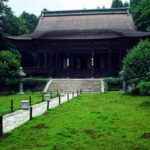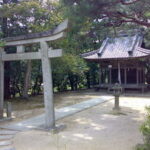Amaterasu is the supreme goddess of Shintoism, a religion practiced mostly in the country of Japan. As a solar deity, goddess of the sun, Amaterasu’s name means “she who illuminates the Heavens.” Most agree the name is well suited to the goddess who was considered warm, compassionate, and benevolent to her people
According to myth, Amaterasu was born from the god Izanagi and goddess Izanamino, the two creation deities credited with the formation of the islands of Japan. Having formed everything from the mountains, rivers, and earth, the pair then set about to create life, beginning with lessor gods that could help them rule.
Their first child, Amaterasu, brought them nothing but pure joy. She was so beautiful and full of such divine light, that her parents immediately set her in the sky to rule the day. Next, they created Tsukiyomi. Not as bright as his sister but with virtues of his own, his parents gave him rule over the moon and night night.
Lastly, they formed Susanoo. But he was not a happy child and was prone to fits and great violent acts. Initially given dominion over the seas, he much enjoyed causing terrible storms that damaged the land. Eventually, his violent temper would cause him to be downgraded to the god of the underworld.
Susanoo was very jealous of Amaterasu’s popularity with the people and he constantly sought to overshadow her. However, nothing he did worked. The people still preferred to worship the goddess whose radiant presence warmed all who believed in her.
His parents, finally disgusted with his shenanigans, informed Susanoo that he was to go rule the underworld and stay there. Blaming his sister for his demotion, he decided to punish her. In a drunken rage he destroyed her rice fields and trashed her palace. He even inadvertently caused the death of her handmaidens through a violent act. Afraid of her brother’s wrath, Amaterasu shut herself inside a cave and refused to come out.
Without the goddess’s sun shining in the sky, all of the crops began to wither and die. Her people suffered without her love and compassion to give them strength and courage. Demons and other evil spirits ran rampant throughout the world, creating havoc. It seemed as though Japan would remain eternally cursed.
However, the gods got together to devise a plan to lure Amaterasu out of the cave. After setting a giant mirror at the mouth of the cave, they all gathered together and began to make noises as though a celebration were in progress.
Curious about the noise, the goddess peeked out of the cave and caught her reflection in the mirror. So stunning was it that she was spellbound by her own image. While she stared at the mirror, the gods shut the cave door behind so that she could not re-enter.
Eventually they were able to convince her to return home. Once there, all of the crops began to grow again. The people were so happy to have Amaterasu back, that they built a shrine in her honor and began a celebration that would continue throughout the years.
The shrine became one of the most important in the Shinto religion. It is the Grand Shrine of Isle in Honshu. It is routinely torn down every 20 years and rebuilt exactly as it was in the beginning. Inside the temple, a mirror has been placed in special recognition of the goddess.
Amaterasu is celebrated twice every year. She is celebrated every July 17th with street celebrations all over Japan. This is in recognition of her contributions to mankind, which include the process to cultivate rice and wheat, the use silkworms to weave silk and the invention of both the weaving process and the loom.Additional festivities take place on December 21st in recognition of her re-emergence from the cave; an event which is credited with saving Japan.
For many years, it was believed that the Japanese royal family members were direct descendants of Amaterasu. As such, Japan’s emperor was considered divine. However, in 1945, the emperor – – in accordance with signed treaties – – disclaimed all forms of divine ancestry and did away with all polytheistic worship in Japan.




